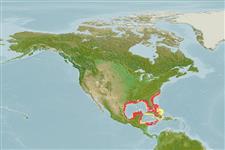Common names from other countries
Environment: milieu / climate zone / depth range / distribution range
Ecology
Marine; demersal. Subtropical; 35°N - 15°N, 98°W - 74°W
Western Atlantic: Florida (USA), Little Bahama Bank (Bahamas) and the entire Gulf of Mexico to Campeche, Mexico (Ref. 7251). Range extended to Brazil (Ref. 94035).
Length at first maturity / Size / Weight / Age
Maturity: Lm 7.6, range 10 - ? cm
Max length : 33.0 cm TL male/unsexed; (Ref. 85752)
Dark brown bars on caudal and pectoral fins; bars on pectoral fin irregularly joined (Ref. 26938).
Commonly found in seagrass beds and rocky cuts in coastal bays and lagoons, and in shallows along open coast. In western coast of Florida, adults spawn in February and March (Ref. 26938). Nesting males produce grunt calls called the boatwhistle as advertisement of competition among males and to attract females (Ref. 45338). Neither opercular nor dorsal gland is venomous (Ref. 57406).
Life cycle and mating behavior
Maturities | Reproduction | Spawnings | Egg(s) | Fecundities | Larvae
Robins, C.R. and G.C. Ray, 1986. A field guide to Atlantic coast fishes of North America. Houghton Mifflin Company, Boston, U.S.A. 354 p. (Ref. 7251)
IUCN Red List Status (Ref. 130435)
CITES (Ref. 128078)
Not Evaluated
Threat to humans
Reports of ciguatera poisoning (Ref. 31174)
Human uses
Tools
Special reports
Download XML
Internet sources
Estimates based on models
Preferred temperature (Ref.
115969): 23.3 - 27.9, mean 24.6 (based on 316 cells).
Phylogenetic diversity index (Ref.
82804): PD
50 = 0.5312 [Uniqueness, from 0.5 = low to 2.0 = high].
Bayesian length-weight: a=0.01288 (0.00798 - 0.02079), b=3.06 (2.92 - 3.20), in cm Total Length, based on LWR estimates for this species & (Sub)family-body (Ref.
93245).
Trophic level (Ref.
69278): 3.7 ±0.6 se; based on size and trophs of closest relatives
Resilience (Ref.
120179): Medium, minimum population doubling time 1.4 - 4.4 years (K=0.218; tm=1+).
Fishing Vulnerability (Ref.
59153): Moderate vulnerability (38 of 100).
